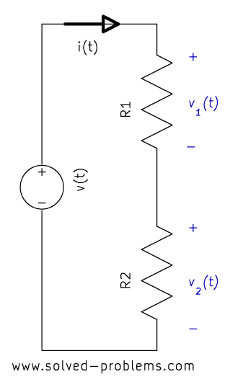The voltage division rule (voltage divider) is a simple rule which can be used in solving circuits to simplify the solution. Applying the voltage division rule can also solve simple circuits thoroughly. The statement of the rule is simple:
Voltage Division Rule: The voltage is divided between two series resistors in direct proportion to their resistance.
It is easy to prove this. In the following circuit

the Ohm’s law implies that
![]() (I)
(I)
![]() (II)
(II)
Applying KVL
![]() .
.
Therefore
![]() .
.
Hence
![]() .
.
Substituting in I and II
![]() ,
,
![]() .
.
Consequently
,
.
which shows that the voltage is divided between two series resistors in direct proportion to their resistance. The rule can be easily extended to circuits with more than two resistors. For example,

![]() ,
,
![]() ,
,
![]() ,
,
![]() .
.
The voltage division rule can be used solve simple circuits or to simplify solving complicated circuits.
For example, check out this problem.
One of the common mistakes in using the voltage division rule is to use the formula for resistors which are in parallel with other elements. For example, the voltage division rule cannot be used in the following circuit directly.

It will be incorrect if one tries to find ![]() using voltage divider by neglecting the other
using voltage divider by neglecting the other ![]() resistor as
resistor as

So, ![]() . However, if solving other parts of a circuits confirms that the current of the other element/branch is zero, the voltage division rule can be still applied. For example, suppose that the following network is a piece of a larger circuit.
. However, if solving other parts of a circuits confirms that the current of the other element/branch is zero, the voltage division rule can be still applied. For example, suppose that the following network is a piece of a larger circuit.

Let’s assume that the analysis of the circuit shows that ![]() . In this case,
. In this case, ![]() regardless of where A and B are connected.
regardless of where A and B are connected.
The voltage devision rule can be used to ease solving problems. For example, the voltage division rule is used in the following problem to find the Thévenin voltage:
Thévenin’s Theorem – Circuit with An Independent Source
.
Leave a Reply to Robert Sumner Cancel reply